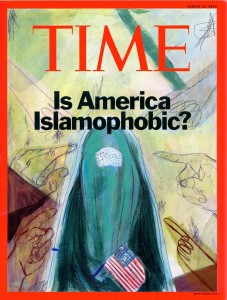 In a world where the Islamophobia and liberal-progressive narratives seem to reign supreme and where cable comics like Jon Stewart and Stephen Colbert can easily riff on the bigotry of Southerners while mocking the Supreme Court’s recent decision to undo a key provision of the civil rights-era Voting Rights Act, we thought it might be useful to examine the recently published 2012 FBI statistics on “hate crimes” reported in the U.S. Gathered from local and state law enforcement agencies, these criminal justice statistics are routinely cited by law enforcement and media as a yardstick for comparing one year to the next.
In a world where the Islamophobia and liberal-progressive narratives seem to reign supreme and where cable comics like Jon Stewart and Stephen Colbert can easily riff on the bigotry of Southerners while mocking the Supreme Court’s recent decision to undo a key provision of the civil rights-era Voting Rights Act, we thought it might be useful to examine the recently published 2012 FBI statistics on “hate crimes” reported in the U.S. Gathered from local and state law enforcement agencies, these criminal justice statistics are routinely cited by law enforcement and media as a yardstick for comparing one year to the next.
Since 9/11, one myth promoted loudly by Muslim civil rights groups in the U.S. is the Muslim victimization narrative. This meme proclaims as fact that Muslims in America are criminally victimized by haters who have bought into an Islamophobic hysteria that all or most Muslims are terrorists or would-be terrorists. The empirical evidence, however, suggests something else altogether.
Thus, during the 12 years following that horrific day in September, and despite the daily headlines reminding us of the gory details of the global jihad against the West, along with the almost weekly reminders in the media of the U.S. homegrown wanna-be Islamic jihadists, the data indicates that Americans are extremely civil and non-violent toward their Muslim neighbors. Specifically, not only are anti-Muslim hate crimes decreasing, the number of anti-Muslims crimes are dwarfed by hate crimes against the perennial victim of religiously motivated hate—the Jews. Thus, from 2010-2012, anti-Muslim hate crime incidents decreased each year from 160 in 2010 to 157 in 2011 to 130 last year. In contrast, hate crimes against Jews were seven times greater, but also showed a decrease: 887 in 2010; 771 in 2011; and 674 in 2012.
And, notwithstanding Jesse Jackson’s recent suggestion that Muslims are the new victimized minority, the empirical reality remains that anti-Black hate crimes dwarf even anti-Jewish hate crimes. Two explanations for this difference of course are the recognition and prevalence factors: Jews represent just a hair over 1% of the U.S. population and shrinking yearly while Blacks represent 12.6% and a Jew walking down the street without the religious garb of an Orthodox Jew is typically not recognizable as a Jew.
But if we return again to the hard cold realities of the numbers, here is what we learn about the myths generated by the Trayvon Martin tragedy, or what has come to be known in the vernacular as “the crime of walking in a hoodie while Black.” Put bluntly, are Blacks more likely to be the target of anti-Black hate crimes than, say, Whites? The numbers look like this:
There were 1805 incidents of anti-Black hate crimes in America in 2012. In contrast, there were 657 incidents of anti-White hate crimes that same year. That is a 2.75 to 1 ratio. The question of course is who are committing these horrendous bigoted hate crimes?
Well, if we look again at the FBI statistics, we find that Whites were the hate crime offenders for 2758 offenses in 2012 while Blacks were the hate crime offenders for 992 offenses. This represents a ratio of approximately 3 to 1.
But, if we turn to the demographics as a whole, Whites represent 72.4% of the U.S. population compared to Blacks at 12.6% . This is a ratio of 5.7 to 1. This suggests that Whites are actually less prone than their Black neighbors to be involved in a hate crime against anyone.
Moreover, if we drill down further into the FBI statistics, we learn something about White on Black hate crimes and Black on White hate crimes. In 2012, there were 739 anti-White offenses of which 305 were committed by Blacks and there were 2180 anti-Black offenses, of which 1206 were committed by Whites. Thus, of the White-Black cross-racial hate crimes, the ratio of such offenders is a bit less than 4 to 1. But, that remains less than the total White-Black ratio of 5.7 to 1, once again suggesting empirically that any given White is no more likely, indeed, the evidence suggests less likely, to attack a Black or her property than the reverse.
Another interesting comparison is between hate crimes committed by the residents of the South and those in the Northeast or West coast. Not surprisingly, the evidence demonstrates that you are far more likely to be a victim of a hate crime in New York or California than Texas or Mississippi.
The tale of the empirical tape is, if not demonstrable, at least telling. So often we find public policy and even public discourse driven by narratives that have no more merit than the typical urban myth. It we want a more peaceful and tolerant civil society and assuming we all strive for a less strident and more reasoned and rational public discussion, the facts are always a good place to start.
